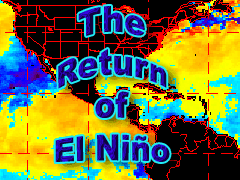|
NOAA Magazine || NOAA Home Page EL NIÑO MAKES ITS OFFICIAL RETURN, NOAA REPORTS
The agency's climate experts today said mature El Niño conditions likely will develop in a few months. In its latest El Niño/Southern Oscillation Diagnostic Discussion, NOAA scientists said weather conditions in the tropical Pacific Ocean, including consecutive months of warmer-than-normal sea-surface temperatures and abnormally heavy rainfall in areas of South America, met NOAA's threshold to be classified as an El Niño. "This time around, El Niño will not be as powerful as the 1997-98 event, but we'll track it closely for any change in its projected strength," said Vernon Kousky, a meteorologist and climate specialist at NOAA's Climate Prediction Center in Camp Springs, Md. Once it matures, Kousky said the El Niño should maintain a weak-to-moderate strength. Data from NOAA's sprawling network of monitoring buoys in the Pacific, and from its environmental satellites in space, detected above-average sea-surface temperatures for several months in the waters of the equatorial Pacific. This usually triggers a chain reaction of atmospheric and weather changes around the globe, including warmer, rainy weather in the southern United States during winter, and drier weather in much of Indonesia throughout El Niño's life cycle. Kousky said El Niño typically does not affect summers in the United States, but historically it tends to suppress Atlantic hurricane activity. He added that El Niño may not be strong enough to be a factor in this year's hurricane season. In May, NOAA released its Atlantic Hurricane season outlook, which called for the potential of nine to 13 tropical storms, with six to eight hurricanes—two to three classified as major (Category 3 or higher on the Saffir-Simpson Hurricane Scale.) The Diagnostic Discussion is a team effort consisting of NOAA's Climate Prediction Center, Climate Diagnostic Center, National Climatic Data Center, Geophysical Fluid Dynamics Laboratory, Atlantic Oceanographic and Meteorological Laboratory, and the International Research Institute for Climate Prediction. The Climate Prediction Center is part of NOAA's Weather Service. NOAA Weather Service is the primary source of weather data, forecasts and warnings for the United States and its territories. NOAA Weather Service operates the most advanced flood warning and forecast system in the world, helping to protect lives and property, and enhance the national economy. Relevant Web Sites ENSO Frequently Asked Questions Sea Surface Temperature Outlook ENSO Impacts by Region
|
